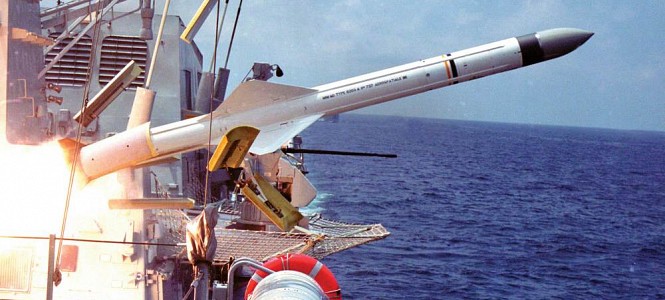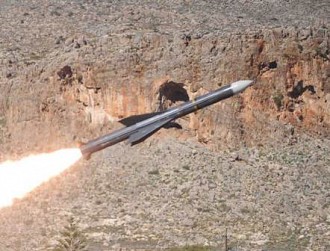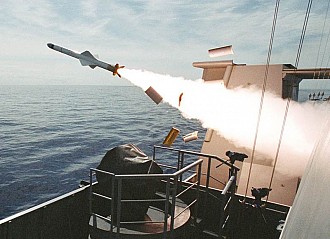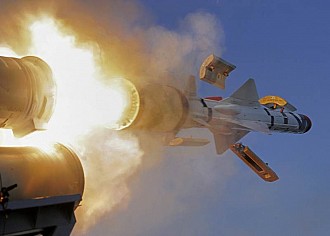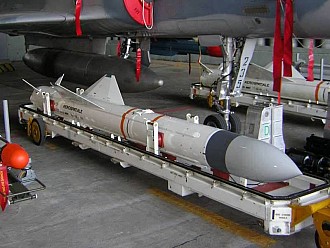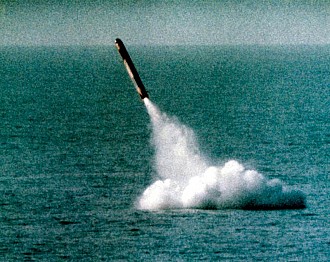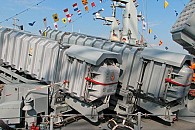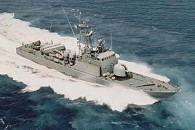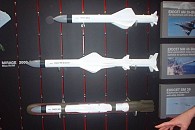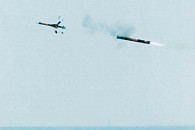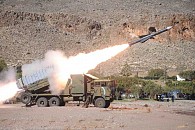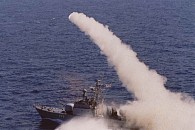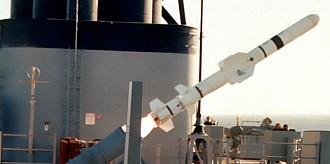Munitions / Surface to surface missiles / Exocet
Exocet
General Facts
- TYPE
Anti-ship missile - ORIGIN
 France
France - NICKNAMES
GWS 50 (UK designation) - DESIGNED
1967 - 1974 - DESIGNER
Nord and Aerospatiale - PRODUCTION
1979 - present - PRODUCERS
 France - Aerospatiale (now MBDA)
France - Aerospatiale (now MBDA) - QUANTITY
1.270 MM38
Over 1.400 AM39 by 1996
Over 230 SM39
Over 700 MM40 - UNIT COST
3 million Euro for SM39 Block 2 in 2007 - CHARACTERISTICS
 Good chance to hit
Good chance to hit
 Sea skimming flight profile
Sea skimming flight profile
 Compatible with many systems/aircraft
Compatible with many systems/aircraft
 Limited range
Limited range
 Limited warhead size
Limited warhead size
Introduction
The Exocet is an anti-ship missile of French origin. It was developed in the early 1970's as armament for surface vessels but submarine and air launched models have been developed as well. The name Exocet is French for flying fish. This name was given either due to their tendency to land themselves in fishing boats or for the missile's sea skimming ability. The Exocet missile became famous during the Falkland war in which both the UK and Argentina used the Exocet. It was most widely used during the Iran - Iraq war.
Design
The Exocet is a conventional missile with a cylindrical body, pointed nose and cruciform wings in the middle and at the rear. The guidance section is located in the front and is followed by the warhead. Most of the missile is made up by the single stage solid propellant rocket motor which powers the missile. Over time the capabilities of the Exocet have been improved by upgrading the electronics and the rocket motor. The latest version has a turbofan engine and has a significantly increased range.
Guidance
The Exocet is fed with target data by the launch platform. Upon launch it travels inertially towards the target area. Later versions add GPS guidance to the inertial navigation and add the ability to follow waypoints. For the final stage the missile uses active radar homing. The radar has a maximum range of 24 km but is normally used within a range of 12 to 15 km. During the cruise phase the Exocet flies at roughly 100 m altitude. Depending on the sea state the final phase is sea skimming at an altitude of 2 to 15 meters.
Firepower
The Exocet is a subsonic sea skimming anti-ship missile that travels at Mach 0.9. The original MM38 has a maximum range of 42 km, the improved MM40 may reach up to 70 km and the latest turbofan powered MM40 Block 3 has the longest range of all with 180 km. The 165 kg HE-frag warhead deals substantial damage but destroyers and larger vessels require multiple hits.
Platform
The MM38 and MM40 are surface launched models that can be launched from a wide variety of vessels and coastal defense systems. The air launched AM39 may be launched from aircraft such as the AMX, Jaguar, Mirage 5, Mirage F-1, Mirage 2000, Super Etendard and Atlantique. Unlike most full size anti-ship missiles the AM39 can also be launched from helicopter such as the Super Puma, Super Frelon and Sea King. The submarine launched SM39 is launched from 533mm torpedo tubes and uses a special steerable capsule.
Users
The Exocet is one the main anti-ship missiles in the world and is fitted to many Cold War era vessels. Compared to the US Harpoon and Italian Otomat the Exocet lacks range and destructive power but it is cheap and easily integrated on many types of vessels. The Exocet remains in production but sales are limited, although the latest models have a much increased performance.
MM38
The MM38 is the original Exocet missile that entered service. It is a surface launched model that is either launched from ships or coastal defense systems. The MM38 has a significant shorter range than the other surface launched models. The MM38 missile itself is easily identified as it is the only Exocet missile with swept back center wings. All other Exocet missiles have trapezoid wings.
- Specifications:
- MM38
| Type | Anti-ship missile |
|---|---|
| Diameter | 0.35 m body, 1 m wingspan |
| Length | 5.21 m |
| Weight | 735 kg |
| Guidance | Active radar homing out to 24 km, inertial navigation |
|---|---|
| Warhead | 165 kg HE-frag, radar and proximity fuze |
| Propulsion | Single-stage solid propellant rocket motor |
| Speed | Mach 0.9 |
| Range | 4 to 42 km |
|---|---|
| Altitude | - |
| Engagement envelope | - |
| Remarks | - |
MM40
The MM40 is a MM38 with a lengthened engine that carries more fuel. Additionally the quality of the fuel has been improved resulting in an effective range which is almost double that of the MM38. The guidance system is virtually similar to the one use on the MM38 except for a wider search angle for the radar seeker. The Block 2 upgrade has a much improved guidance section but carries a slightly lighter warhead.
MM40: Original MM40 introduced in 1980, sometimes called MM40 Block 1.
MM40 Block 2: Improved MM40 introduced in the mid 1980's with improved radar, ECCM features and lower sea skimming ability.
- Specifications:
- MM40
- MM40 Block 2
| Type | Anti-ship missile |
|---|---|
| Diameter | 0.35 m body, 1.13 m wingspan |
| Length | 5.79 m |
| Weight | 875 kg |
| Guidance | Active radar homing out to 24 km, inertial navigation |
|---|---|
| Warhead | 165 kg HE-frag, radar and proximity fuze |
| Propulsion | Single-stage solid propellant rocket motor |
| Speed | Mach 0.9 |
| Range | 4 to 70 km |
|---|---|
| Altitude | - |
| Engagement envelope | - |
| Remarks | - |
| Type | Anti-ship missile |
|---|---|
| Diameter | 0.35 m body, 1.13 m wingspan |
| Length | 5.8 m |
| Weight | 870 kg |
| Guidance | Active radar homing out to 24 km, GPS and inertial navigation |
|---|---|
| Warhead | 155 kg HE-frag, radar and proximity fuze |
| Propulsion | Single-stage solid propellant rocket motor |
| Speed | Mach 0.9 |
| Range | 4 to 75 km |
|---|---|
| Altitude | - |
| Engagement envelope | - |
| Remarks | - |
MM40 Block 3
The MM40 Block 3 is a MM40 Block 2 with a turbofan engine, an engine type which is also found on other anti-ship missiles in the Exocet class such as the US Harpoon and Chinese YJ-82. The new engine results in a range which is twice that of the original MM40. The Block 3 can be identified by the four air intakes behind the wings. Unlike the other Exocet missiles the Block 3 features a large booster engine to provide initial velocity. The Block 3 missile is slightly shorter but with booster attached it is just as long as the Block 2.
- Specifications:
- MM40 Block 3
| Type | Anti-ship missile |
|---|---|
| Diameter | 0.35 m body, 1.13 m wingspan |
| Length | 5.8 m incl booster |
| Weight | 740 kg |
| Guidance | Active radar homing out to 24 km, GPS and inertial navigation |
|---|---|
| Warhead | 155 kg HE-frag, radar and proximity fuze |
| Propulsion | Single-stage solid propellant rocket motor |
| Speed | Mach 0.9 |
| Range | 4 to 180 km |
|---|---|
| Altitude | - |
| Engagement envelope | - |
| Remarks | - |
AM39
The AM39 is the air launched model of the MM38 Exocet. It was introduced in 1979. The AM39 is an MM38 with slightly improved engine and modified control surfaces. An air launched model called AM38 for use only on helicopter was considered but never developed.
AM39: Original air launched Exocet introduced in 1979.
AM39 Block 2: Improved AM39 introduced in 1994 with improved radar, ECCM features and lower sea skimming ability.
- Specifications:
- AM39
| Type | Anti-ship missile |
|---|---|
| Diameter | 0.35 m body, 1.1 m wingspan |
| Length | 4.69 m |
| Weight | 670 kg |
| Guidance | Active radar homing out to 24 km, inertial navigation |
|---|---|
| Warhead | 165 kg HE-frag, radar and proximity fuze |
| Propulsion | Single-stage solid propellant rocket motor |
| Speed | Mach 0.9 |
| Range | 50 km, 70 km from 10 km altitude |
|---|---|
| Altitude | - |
| Engagement envelope | - |
| Remarks | - |
SM39
The SM39 is a submarine launched version of the Exocet introduced in 1985. The SM39 is encased in an underwater launch vehicle with similar dimensions as a 533mm torpedo. The SM39 is launched from a torpedo tube and will start to sink. After a few seconds the rocket motor ignites and provides propulsion underwater. When the capsule breaks the surface after performing underwater maneuvers to obscure the submarine's position the nose cone is ejected and Exocet is launched in the air. In mid air the wings unfold and the main rocket motor ignites.
SM39: Original submarine launched Exocet introduced in 1985.
SM39 Block 2: Improved SM39 introduced in the mid 1990's with improved radar, ECCM features and lower sea skimming ability.
- Specifications:
- SM39
| Type | Anti-ship missile |
|---|---|
| Diameter | 0.35 m body, 1.13 m wingspan |
| Length | 4.69 m |
| Weight | 655 kg |
| Guidance | Active radar homing out to 24 km, inertial navigation |
|---|---|
| Warhead | 165 kg HE-frag, radar and proximity fuze |
| Propulsion | Single-stage solid propellant rocket motor |
| Speed | Mach 0.9 |
| Range | 4 to 50 km |
|---|---|
| Altitude | - |
| Engagement envelope | - |
| Remarks | 5.8 m long in capsule and weighs 1.350 kg |

